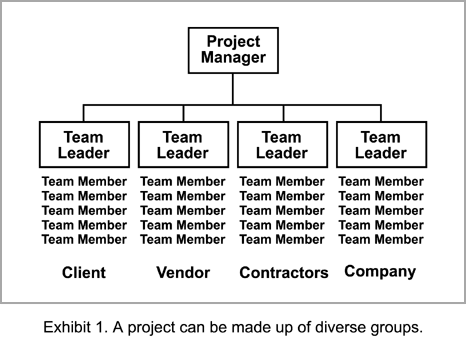Whether they are clients, vendors, contractors or company employees, a project suffers when preferential treatment is given to any group or person.
by Neal Whitten, PMP, Contributing Editor
WHAT IF A PROJECT is made up of client personnel, vendors, and contractors, in addition to the company’s personnel? How should the project manager relate to each of these diverse groups?
This is a common problem on many projects, yet the answer is simple: Once people are assigned to a project, regardless of where they hail from, they must all be treated the same. No exceptions!
Exhibit 1 shows a project that consists of all of these groups. For purpose of illustration, each team is led by a team leader and is made up of a different group of project members: client personnel, vendor personnel, contractors, and company personnel. Note that, although not depicted in this example, it is possible that a team can consist of a mixture of people from these different groups.
Once the project members have been assigned to the project, the project manager should not focus on their origins. The focus must be on the project, the commitments from each team, and on the corresponding actions that each project member performs toward achieving their assigned tasks. The project manager sees everyone as a project member and will work with each person and group as if they were personnel from the same project team … because they are!
Each team is expected to have plans, commit to those plans, and track according to those plans. If any team is in trouble, or headed that way, the project manager initiates the attention required to help the team get back on plan. Every team is held just as accountable for their commitments as any other team.
I commonly see project managers treat the client’s personnel assigned to the project with kid gloves, quick to cut them slack at every turn. I often see vendors treated as if they are a “black box” that cannot be tampered with, their whims easily accepted as “cast in stone,” with no or little chance of altering. I see contractors treated as second-class members of the team, where project information is often withheld from them—information that they need to fully function as members of the project. And I often see company employees treated harshly because of the view that they are the most accessible project members and, therefore, the most easily manipulated.
A PROJECT’S SUCCESS is dependent upon the success of each and every project member. An effective project manager recognizes this and works consistently, firmly, and unbiasedly across all members of a project to ensure the project completes successfully.
